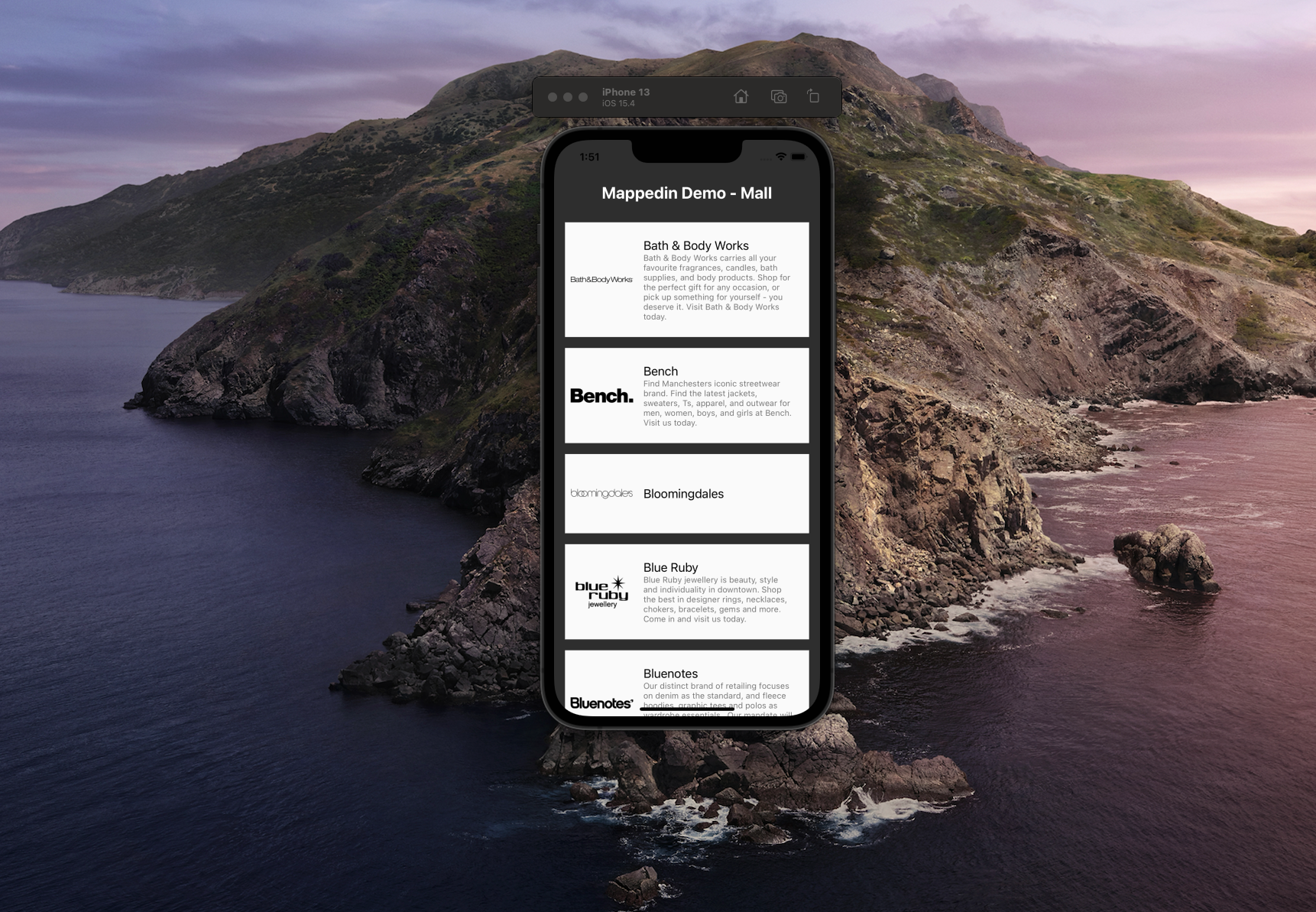Listing Locations
Using Mappedin SDK for React Native with your own map requires an Enterprise license. Try a demo map for free or refer to the Pricing page for more information.

Prerequisites
This guide goes a step deeper from the React Native Getting Started guide, which helps you set up a new React Native project from scratch and install Mappedin SDK for React Native as a dependency.
Setup
Let's start by setting up our imports, the <App /> component and an empty React Native stylesheet. We will render a list of locations and their descriptions so to keep everything readable, we need to apply some basic styling at the end.
import React from 'react';
import { FlatList, ListRenderItem, Text, StyleSheet, View, SafeAreaView } from 'react-native';
import { Mappedin, getVenue, MappedinLocation } from '@mappedin/react-native-sdk';
const App = () => {};
const styles = StyleSheet.create({
loading: {},
container: {},
venueName: {},
item: {},
title: {},
image: {},
description: {},
});
export default App;
Loading Venue data without displaying a map
It is possible to fetch venue data (locations, maps, etc), outside of the <MiMapView /> component. This can be helpful for cases where a map isn't always needed or there is a need to fetch the data first, and render the map later.
To do that, we need to set up a hook to asynchronously download the data when our <App /> component is rendered. A loading screen is displayed while venueData is not defined. Once the data is received, the component is re-rendered and should display Mappedin Demo - Mall, the name of our demo venue in the top left corner of the screen.
// See Trial API key Terms and Conditions
// https://developer.mappedin.com/docs/demo-keys-and-maps
const options = {
clientId: '5eab30aa91b055001a68e996',
clientSecret: 'RJyRXKcryCMy4erZqqCbuB1NbR66QTGNXVE0x3Pg6oCIlUR1',
venue: 'mappedin-demo-mall',
};
const App = () => {
const [venueData, setVenueData] = React.useState<Mappedin>();
React.useEffect(() => {
async function init() {
const venueData = await getVenue(options);
setVenueData(venueData);
}
init();
}, []);
if (!venueData) {
return (
<View style={styles.loading}>
<Text>Loading</Text>
</View>
);
}
return (
<SafeAreaView style={styles.container}>
<Text style={styles.venueName}>{venueData.venue.name}</Text>
</SafeAreaView>
);
};
Adding a list view
To display a list of locations, we use FlatList from React Native. <FlatList /> takes the location data. Because React requires a key for each element, we define a keyExtractor. renderItem function defines how each item is displayed. We are rendering the location name and the description if it has any.
const LocationList = ({locations}: {locations: MappedinLocation[]}) => {
const renderItem: ListRenderItem<MappedinLocation> = ({item}) => (
<View style={styles.item}>
<Image source={{uri: item?.logo?.small}} style={styles.image} />
<View style={styles.info}>
<Text style={styles.title}>{item.name}</Text>
{item.description && <Text style={styles.description}>{item.description}</Text>}
</View>
</View>
);
return (
<FlatList
data={locations}
renderItem={renderItem}
keyExtractor={(item: any) => item.id}
/>
);
For the location data, we will roughly sort it based on the tenant type and in alphabetical order based on the location name. To render the list in our application under the venue name, we can now add <LocationList locations={venueData.tenants} /> to our <App /> component's return.
const tenants = venueData.locations.filter((loc) => loc.type === 'tenant').sort((a, b) => (a.name > b.name ? 1 : -1));
return (
<SafeAreaView style={styles.container}>
<Text style={styles.venueName}>{venueData.venue.name}</Text>
<LocationList locations={tenants} />
</SafeAreaView>
);
Styling
To add some basic styles, we can now fill our stylesheet with the following:
const styles = StyleSheet.create({
item: {
color: '#2E2E2E',
backgroundColor: '#FAFAFA',
padding: 8,
marginVertical: 8,
marginHorizontal: 16,
alignItems: 'center',
flexDirection: 'row',
},
info: {
padding: 15,
width: 250,
},
image: {
flex: 1,
width: 100,
height: 100,
resizeMode: 'contain',
},
title: {
fontSize: 18,
},
description: {
fontSize: 12,
color: '#777',
},
container: {
backgroundColor: '#2E2E2E',
},
loading: {
flex: 1,
justifyContent: 'center',
alignItems: 'center',
},
venueName: {
margin: 16,
fontSize: 24,
fontWeight: 'bold',
color: 'white',
textAlign: 'center',
},
});
Complete code example
import React from 'react';
import { FlatList, ListRenderItem, Text, StyleSheet, View, SafeAreaView, Image } from 'react-native';
import { Mappedin, getVenue, MappedinLocation } from '@mappedin/react-native-sdk';
// See Trial API key Terms and Conditions
// https://developer.mappedin.com/docs/demo-keys-and-maps
const options = {
clientId: '5eab30aa91b055001a68e996',
clientSecret: 'RJyRXKcryCMy4erZqqCbuB1NbR66QTGNXVE0x3Pg6oCIlUR1',
venue: 'mappedin-demo-mall',
};
const LocationList = ({ locations }: { locations: MappedinLocation[] }) => {
const renderItem: ListRenderItem<MappedinLocation> = ({ item }) => (
<View style={styles.item}>
<Image source={{ uri: item?.logo?.small }} style={styles.image} />
<View style={styles.info}>
<Text style={styles.title}>{item.name}</Text>
{item.description && <Text style={styles.description}>{item.description}</Text>}
</View>
</View>
);
return <FlatList data={locations} renderItem={renderItem} keyExtractor={(item: any) => item.id} />;
};
const App = () => {
const [venueData, setVenueData] = React.useState<Mappedin>();
React.useEffect(() => {
async function init() {
const venueData = await getVenue(options);
setVenueData(venueData);
}
init();
}, []);
if (!venueData) {
return (
<View style={styles.loading}>
<Text>Loading</Text>
</View>
);
}
const tenants = venueData.locations
.filter((loc) => loc.type === 'tenant')
.sort((a, b) => (a.name > b.name ? 1 : -1));
return (
<SafeAreaView style={styles.container}>
<Text style={styles.venueName}>{venueData.venue.name}</Text>
<LocationList locations={tenants} />
</SafeAreaView>
);
};
const styles = StyleSheet.create({
item: {
color: '#2E2E2E',
backgroundColor: '#FAFAFA',
padding: 8,
marginVertical: 8,
marginHorizontal: 16,
alignItems: 'center',
flexDirection: 'row',
},
info: {
padding: 15,
width: 250,
},
image: {
flex: 1,
width: 100,
height: 100,
resizeMode: 'contain',
},
title: {
fontSize: 18,
},
description: {
fontSize: 12,
color: '#777',
},
container: {
backgroundColor: '#2E2E2E',
},
loading: {
flex: 1,
justifyContent: 'center',
alignItems: 'center',
},
venueName: {
margin: 16,
fontSize: 24,
fontWeight: 'bold',
color: 'white',
textAlign: 'center',
},
});
export default App;

For more examples in topics such as directions and BlueDot positioning in React Native, have a look at our example repository.